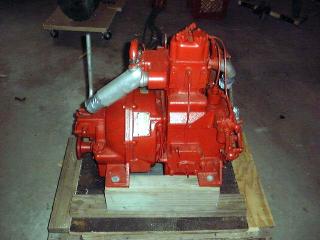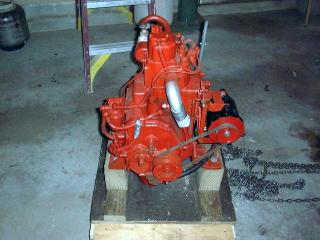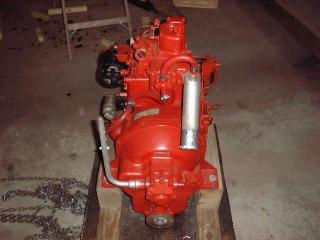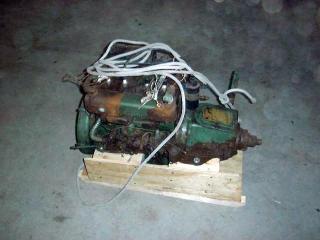|
Yanmar SB12
|
Before you
read on: in case you don't already know, we had bad luck with this engine,
and have since removed it and replaced it with a brand new Yanmar. I have
left the text of this page the way it was when I originally wrote it in January
2000, so some of the statements may not hold up! Read on for the whole
saga...
|
|
 These are photos of a Yanmar SB-12 diesel engine that we have purchased for
Glissando. We found the engine advertised in
Good Old Boat Magazine after searching for several weeks on the Internet and
elsewhere. These are photos of a Yanmar SB-12 diesel engine that we have purchased for
Glissando. We found the engine advertised in
Good Old Boat Magazine after searching for several weeks on the Internet and
elsewhere.
The engine was purportedly in good condition, reported as having been lightly used--less than 1000 hours, probably around 750--by the owner of a Newport 28. Apparently, the owner was a liveaboard who never moved the boat from the slip. When the boat was sold, the new owner discovered he couldn't start the engine, so he ran right out
and bought an outboard instead. The person from whom we are buying the
engine is retired but runs a small engine rebuilding service, rebuilding many Atomic 4's and other small sailboat engines. After hearing about the engine, he removed it from the Newport 28, took it to his shop and, with minor work--a new starter, injector service and acid flush--started the engine right up.
|
|
 The engine was located in Florida, so we weren't able to actually see it before purchase. However, we did get some photos sent up, and I got the necessary information from numerous emails and phone calls to
the seller. I also purchased a service manual for the engine, even before making the
commitment to buy it, so that I could really check over the installation dimensions and make sure that it would fit in the space available. Because the old galley is gone, we will be able to move the engine slightly forward from where the old A4 was installed. This will not only give more room all around, but will allow the engine to fit well. It would not have fit in the original space, as it is quite a bit taller than the A4 and a little longer and wider. The engine was located in Florida, so we weren't able to actually see it before purchase. However, we did get some photos sent up, and I got the necessary information from numerous emails and phone calls to
the seller. I also purchased a service manual for the engine, even before making the
commitment to buy it, so that I could really check over the installation dimensions and make sure that it would fit in the space available. Because the old galley is gone, we will be able to move the engine slightly forward from where the old A4 was installed. This will not only give more room all around, but will allow the engine to fit well. It would not have fit in the original space, as it is quite a bit taller than the A4 and a little longer and wider.
The engine arrived at a nearby shipping depot on Wednesday, 12 January 2000. After receiving a call from the depot, I drove over to pick up the engine. They loaded it into the back of my truck with a forklift, I tied it down and brought it home. Having no time that late afternoon to unload it, I spent just a little time unwrapping the crate from its plastic and removing much of the protective shipping crate.
|
 The next morning, I moved the truck out of the garage/shop so I could set up a beam from which to lift the engine, similar to the rig I used to
remove the old engine from the boat. I used two 6' stepladders, set far enough apart to pull the truck between, and set up my 4x6 timber on the top rung. Knowing that this didn't provide close to enough clearance to lift the engine with the chain hoist (which I purchased from the rental center, deciding that it would be handy to have, and, since I
will be needing it several more times for this project alone, will probably end up being less expensive than multiple rentals--not to mention more convenient than driving 30 miles round trip to rent it each time), I raised the beam with blocking. I am unable to use the garage roof structure as a lifting point because the trusses are only 2x4, and I didn't want to put such a point strain on them. Plus, the ceiling is insulated and covered with a plastic vapor barrier that I did not want to compromise. Backing the truck in beneath this rig, I discovered that it was still not tall enough to lift the engine clear of the bed and tailgate--and I had blocked it almost to the ceiling! The truck bed is quite high, plus the problem, minor though it generally is, that the chain hoist requires a fair bit of clearance itself--probably 12" or so. The next morning, I moved the truck out of the garage/shop so I could set up a beam from which to lift the engine, similar to the rig I used to
remove the old engine from the boat. I used two 6' stepladders, set far enough apart to pull the truck between, and set up my 4x6 timber on the top rung. Knowing that this didn't provide close to enough clearance to lift the engine with the chain hoist (which I purchased from the rental center, deciding that it would be handy to have, and, since I
will be needing it several more times for this project alone, will probably end up being less expensive than multiple rentals--not to mention more convenient than driving 30 miles round trip to rent it each time), I raised the beam with blocking. I am unable to use the garage roof structure as a lifting point because the trusses are only 2x4, and I didn't want to put such a point strain on them. Plus, the ceiling is insulated and covered with a plastic vapor barrier that I did not want to compromise. Backing the truck in beneath this rig, I discovered that it was still not tall enough to lift the engine clear of the bed and tailgate--and I had blocked it almost to the ceiling! The truck bed is quite high, plus the problem, minor though it generally is, that the chain hoist requires a fair bit of clearance itself--probably 12" or so.
The only way to get the engine off was to unbolt it from its temporary foundation and pallet, on which it had been shipped. Doing this--a simple matter of removing four lag screws into the wood--removed nearly a foot from the required lift, and I was then able to easily lift the engine clear. One of my ladders is somewhat rickety, and with the high blocking the whole rig was not the most stable thing, so I quickly moved the truck and prepared to lower the engine back down to its wooden cradle. |
|




|
|



|
|
 I
have a simple rolling platform dolly that I built some years ago--basically two layers of 3/4" plywood with four heavy duty swivel casters bolted to it. This proved handy for storing the Atomic 4 in September, as it makes it easy to move the engine around as needed. I wanted to put the Yanmar on the platform, for ease of storage and movement, and the A4 moved to Rhode Island as of Saturday January
15 2000, the new possession of a fellow Tritoner there. So, I lifted it with the hoist and constructed a very simple foundation out of 2x4s and plywood, to which I attached the engine for its transport. I can also drag the little sled out of the way with the rope--and just a little grunting! We have no sentiment attached to this motor, as we never ran it, so there's no teary "so long old girl" speech coming or anything. Hopefully it makes its new owner happy, either for parts or as a rebuild project. We do wish him all success. I
have a simple rolling platform dolly that I built some years ago--basically two layers of 3/4" plywood with four heavy duty swivel casters bolted to it. This proved handy for storing the Atomic 4 in September, as it makes it easy to move the engine around as needed. I wanted to put the Yanmar on the platform, for ease of storage and movement, and the A4 moved to Rhode Island as of Saturday January
15 2000, the new possession of a fellow Tritoner there. So, I lifted it with the hoist and constructed a very simple foundation out of 2x4s and plywood, to which I attached the engine for its transport. I can also drag the little sled out of the way with the rope--and just a little grunting! We have no sentiment attached to this motor, as we never ran it, so there's no teary "so long old girl" speech coming or anything. Hopefully it makes its new owner happy, either for parts or as a rebuild project. We do wish him all success.
Installation of the Yanmar in the Triton will require substantial modification of the engine room and engine mounting system, details of which will be posted on this page as progress dictates. The old Atomic 4 engine beds have already been removed, having been damaged when I pulled the A4 in September--they were in pretty bad shape anyway. Stay tuned for updates--the installation project should be an interesting one, although perhaps one of the most challenging of Glissando's renovation. We should have the engine installed by early spring, which will allow construction to begin on the new galley and salon cabinetry around the engine.
We will also be installing a new
water lift exhaust system. Constructing a safe system that meets applicable standards and requirements will be a challenge, and will likely require replacement of the Yanmar exhaust mixer (silver tube at the rear of the engine). All details will be posted as progress permits.
I expect to begin the engine foundation work in late March or early April. Should be a trial and error process, but at the cost of only
time.
Please
click here to continue with the engine installation.
|
|